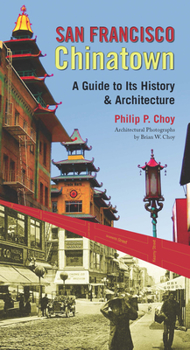San Francisco Chinatown: A Guide to Its History and Architecture
Select Format
Select Condition 
Book Overview
San Francisco Chinatown is the first history of and guide to SF Chinatown written by someone born and raised there.
Format:Paperback
Language:English
ISBN:0872865401
ISBN13:9780872865402
Release Date:August 2012
Publisher:City Lights Books
Length:184 Pages
Weight:0.50 lbs.
Dimensions:0.7" x 4.6" x 8.4"
Customer Reviews
1 rating
I left my heart in SF Chinatown!
Published by Walter KO , 3 years ago
This is a book by a Chinese native-born authority in San Francisco Chinatown history with an architecture perspective supplemented by his son Brian in photographs. Philip does a good job in giving readers in short yet comprehensive history background from Spanish to Mexican and American periods and the development of Chinatown from welcome in 1850s to open anti-Chinese politics and hostility. The 1906 San Francisco Earthquake and Fire was a heavenly sent opportunity to the Chinese. In this chapter, there are many vintage photos and pictures from that period ranging from prefabricated wooden houses to the ruins after the Quake.
He starts from the heart of Chinatown, Portsmouth Plaza with seven major attractions. The pictures then and now show the contrast. He not only describes the building structures but also points out their political history. The next is Sacramento Street which housed two Chinese newspapers, Chung Sai Yat Po and Chinese Daily Post in the old days. The text brings back their glory days in serving the locals in news affecting their lives.
The three sections of Grant Avenue are important as the central section is full of hustle and bustle. Philip introduces the building characters, especially the Chinese Telephone Exchange as the main focal point
Stockton is different from Grant with more religious and political organizations. Page 76 gives some incidents on Catholic and Protestants in anti-Chinese rally. They were fighting in saving the souls of Chinese brethren who were their neighbors. He devotes a few pages on Chinese YWCA building which now is the Museum home of Chinese Historical Society of America. He also talks about hospital and school. Some of the organizations such as Kong Chow Benevolent Association and Kuomintang pass the century mark. Bess Truman visited the Kong Chow temple in 1948, where she prayed for positive results for her husband, Harry S. Truman's presidential run. The prediction was favorable, and Truman would go on to win the presidential election. The prediction slip that was given to her is displayed in the temple.
The Ross and Spofford Alleys and Waverly Place are meaningful in history in serving Spanish and Chinese need alike. The Chee Kung Tong was important in helping Dr. Sun in his revolution in founding the Chinese Republic in 1911. Of interest is that on the outside wall bears the symbols of Freemasons of square and compass and letter G. They even proclaimed Chinese Freemasons in English. It seems Freemasons land a hand to the Chinese during the anti-Chinese era. This section also introduces the Chinese temple.
The last chapter suggests walking tours with maps pinpointing the places of interests. This self guide is helpful for locals and visitors as it brings history alive with interesting facts. Despite a few minor errors such as the death of Dr. Sun (1926 not 1915 p.49), this is a good convenient pocket tourist companion.
Readers will be happy to follow Philip's guide and may leave their hearts in San Francisco Chinatown in sightseeing, shopping and dining.





